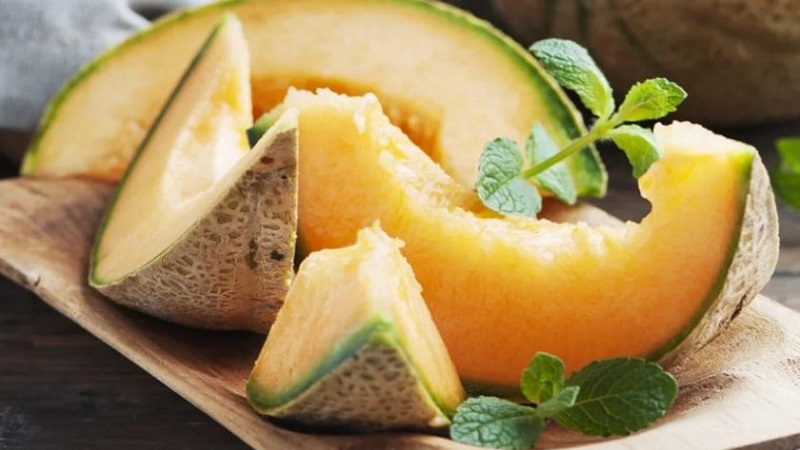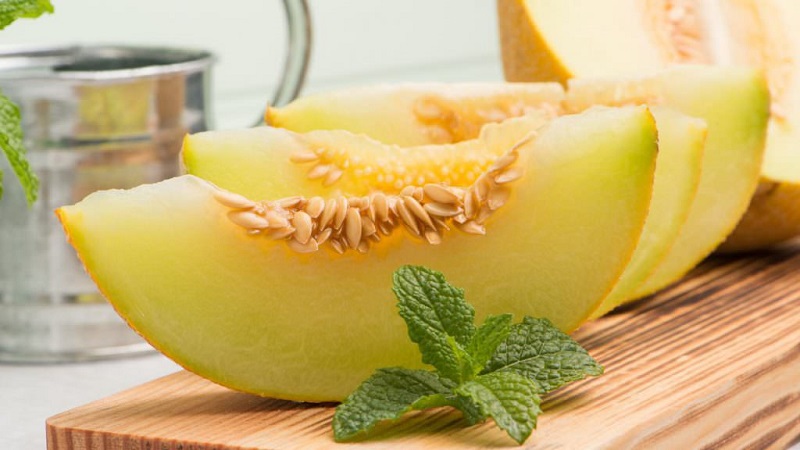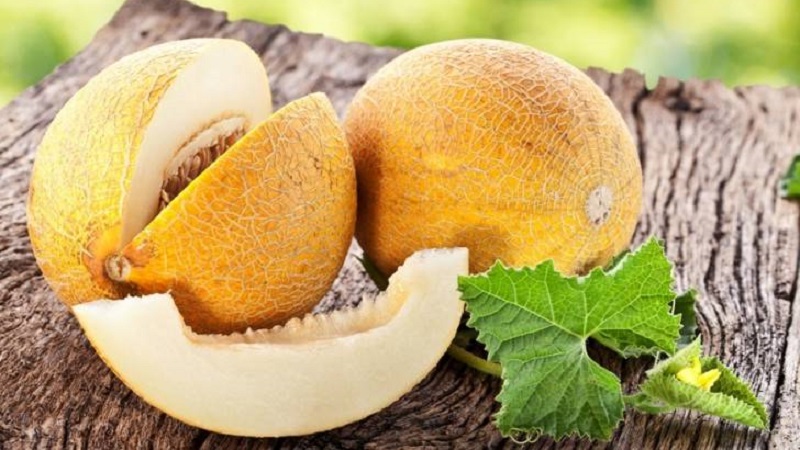Is it possible to eat a melon for gout and how is it useful
Treatment for gout is long-term and complex. Diet plays an important role in the treatment of patients. Proper nutrition helps to normalize uric acid production and improve overall health. A varied, nutritious diet is recommended, where food of plant origin and dairy products are in priority.
Melon is especially useful for gout. It affects the metabolism of purines in the body, acts as an antioxidant, a diuretic, removes toxic metabolic products from the body, and prevents the deposition of uric acid salts. In the article, we will consider the useful properties of the product for the treatment and prevention of gout, how to use it correctly and in what quantity so as not to harm the body.
The content of the article
Briefly about the disease
Gout, a rheumatic disease caused by the deposition of sodium monourate crystals in various tissues... The disease is based on metabolic disorders: increased synthesis and decreased excretion of uric acid and its derivatives - acidic urate salts in the urine. The content of uric acid in the blood increases, urate crystals accumulate in the tissues, then in the kidneys, causing acute inflammation.

Factors in the development of the disease include: heredity, obesity, diet, excessive consumption of alcohol, meat, inactive lifestyle. Gout can be secondary and develop in conditions of concomitant pathologies such as diabetes mellitus, metabolic disorders, arterial hypertension, psoriasis, leukemia, and blood diseases.
In the early period, there are no specific symptoms... As the disease progresses, attacks of acute arthritis appear, alternating with asymptomatic periods. Gouty attacks are manifested by acute, sharp pain in the metatarsophalangeal joint of the first toe, local fever, swelling and redness of the skin over the joint, and impaired motor functions. After 4-10 days, the attack passes with the disappearance of the accompanying symptoms and the restoration of motor activity. Repeated relapses are possible after several months or even years, but each time the intervals between gouty attacks are shortened.
The main goal of gout treatment is to reduce the concentration of uric acid, both in the blood and urine. To achieve optimal results, it is recommended to combine pharmacological and non-pharmacological approaches to therapy. Patients need the appointment of non-steroidal anti-inflammatory drugs, urate-lowering drugs. If relief does not come, glucocorticosteroids are injected intramuscularly.
All patients are prescribed a diet that excludes the consumption of offal, fatty meat broths, red meat, legumes and vegetables, salt... It is allowed to eat eggs, low-fat fish, meat, poultry, dairy products with a low fat content, some vegetables, fruits, berries. Nutritionists recommend including watermelons and melons in the diet. Melons have a diuretic effect, which accelerates the process of excretion of uric acid from the body.
Read also:
Melon is a berry, fruit or vegetable
Is it possible to eat a melon with gout
Melon has long been successfully used for the treatment and prevention of diseases of the musculoskeletal system.... It is especially useful for gouty arthritis, as it has a versatile effect on the pathological process: it suppresses inflammation, reduces fluid content in tissues, normalizes metabolism, is a good antioxidant and diuretic.

With regular consumption, you can achieve positive dynamics in the treatment of gout in a shorter time., reduce the need for medication. Melon is recommended to be included in the diet for the prevention of rheumatic diseases and complications.
Like all products, melon has contraindications, which are important to identify and exclude in advance.... In order to get the maximum benefit for the body without the threat of adverse reactions, it is important to consume the fruits in moderation and only after consultation with your doctor. The question of whether it is possible to eat a melon during the period of gouty arthritis is decided individually, taking into account the age of the patient, the presence of concomitant pathologies, the characteristics of the development of the disease and the dynamics of treatment.
Reference. Melon is mainly consumed fresh after peeling, as well as dried, dried, canned, processed into juice, honey, candied fruit. The seeds are also used as a medicine.
Disease properties
Melon's healing properties are determined by its unique chemical composition, thanks to it affects different aspects of the development and course of gouty arthritis:
- ascorbic acid - has a metabolic effect, accelerates tissue healing, participates in the formation of collagen and steroid hormones, maintains normal permeability of capillary walls, stimulates bile secretion, strengthens immunity, inhibits inflammation;
- fiber - cleanses the body of toxins and toxins, normalizes blood sugar levels, lowers cholesterol concentration, maintains normal intestinal microbiocenosis;
- vitamin B8 - improves the transmission of nerve impulses, restores and maintains liver function, neutralizes cholesterol, starts the gastrointestinal tract, activates lipid metabolism, lowers high blood pressure, which is especially important when gout develops against a background of hypertension;
- carotene - regulates protein synthesis, normalizes metabolic processes, is necessary to improve the properties and composition of bone tissue, is a good antioxidant;
- folic acid (vitamin B9) - ensures the normal functioning of the immune system, participates in the exchange of purines, amino acids, nucleic acid synthesis, hematopoiesis processes, maintains the health of new body cells;
- nicotinic acid (vitamin B3) - improves the state of tissue metabolism and microcirculation, reduces puffiness, normalizes the lipid composition of the blood, lowers cholesterol, regulates the metabolism of purines, amino acids, fats;
- vitamin D - ensures the normal development of bones, prevents softening of bone tissue, affects the general metabolism, promotes the deposition of calcium in bones;
- vitamin E - protects against the formation of free radicals, supports metabolic processes in skeletal muscles, increases immunity, normalizes weight, reduces blood glucose levels;
- vitamin K - improves absorption and regulates the level of calcium in the blood, normalizes metabolism in connective and bone tissue, is necessary for the normal functioning of the liver, kidneys, gall bladder;
- iodine - has a beneficial effect on protein and lipid metabolism, enhances metabolic decay processes, has anti-inflammatory, antiseptic and local irritating effects.
Systematic consumption of melon with gout saturates the body with micro- and macroelements: sodium, potassium, calcium, magnesium, phosphorus, iron, manganese, copper, selenium, fluorine, zinc.
Benefit and harm
Melon has a general beneficial effect on the body, the functions of the musculoskeletal system... It is a source of vitamins of group A, B, C, E, K, PP, micro- and macroelements necessary for the normal maintenance of vital processes in organs and tissues.
Melon has anti-inflammatory, analgesic, tonic, antiseptic, diuretic, antioxidant effect, to a lesser extent has a laxative effect. The consumption of sweet fruit helps to replenish iron deficiency, improve the degree of its absorption, and has a positive effect on the composition and properties of blood.
Melon is included in the diet for diseases of the cardiovascular, digestive, nervous, urinary systems... It normalizes metabolism, removes chloride salts, excess fluid from the body. Due to the presence in the composition of fiber, it cleanses the digestive tract well, while practically does not contain fats, activates lipid metabolism, which contributes to weight loss.
Melon has a calming effect on the nervous system, relieves anxiety, and normalizes night sleep, improves mood, improves the condition of the skin, hair, nails, strengthens the immune system.
Negative reviews about the dangers of melon for the body are rare... They are associated with excessive use or individual intolerance to the product. Melon can be harmful when combined with dairy products and alcoholic beverages. Breastfeeding mothers should be wary of melon as it can cause digestive problems in the baby.
On the beneficial properties of other crops:
Effects on uric acid
Biologically active components in the composition of melon fruits affect the exchange of purines: reduce the concentration of uric acid salts, prevent the formation of urate deposits in the tissues of the body and the renal system, promote their dissolution, have an analgesic effect.

Melons are used to treat gout as a diuretic.: it disrupts the absorption of chlorine and sodium ions in the kidney tubules, increases the rate of urine formation and increases their excretion in the urine. As a result, the volume of fluid filling the intercellular spaces in organs and tissues decreases, and the edema subsides.
Reference. Today there is no consensus on what a melon is - a berry, fruit or vegetable. According to the culinary and botanical classification, melon is defined as a fruit: it tastes sweet and is found in fruit salads, desserts, and drinks. Biologists classify melon as a vegetable crop, as it grows on herbaceous plants, has a long stem, belongs to the pumpkin family, and is related to cucumber, pumpkin, and zucchini. In addition, melons are characterized by the characteristics of berries: a thin skin on the outside, hard seeds on the inside, a juicy center, so the version that the melon is a false berry cannot be ruled out.
Rules and norms of consumption
The daily rate of melon depends on the patient's age, the characteristics of the course of the disease, the presence of concomitant pathologies, the state of the digestive system... Nutritionists advise to use the product as a snack between meals without drinking water, milk, juice, etc. The average daily norm is 200-300 g.
A one-day fasting day on a melon involves 6-8 doses of the product, 200-300 g each, but not more than 1.5-2 kg in 24 hours. Such a diet is considered strict due to its low calorie content, so it can be used no more than once every two weeks.
Advice... It is not recommended to eat the melon off-season or early in the sale due to the risk of high levels of chemicals and nitrates, which are used to accelerate the growth and ripening of the fruit.
Contraindications
The list of contraindications is limited by a history of product allergy, diabetes mellitus and dyspepsia (digestive disorders).However, in order to avoid possible side reactions in the form of a local allergic reaction, it is necessary to consult a doctor before eating melon.

Conclusion
Proper nutrition and vitaminization of the diet are of great importance for gout. Nutritionists call watermelons and melons among the must-haves. Their regular use enhances the effect of diuretic drugs, relieves pain and inflammation, and increases physical activity. However, to achieve positive dynamics in the treatment of gouty arthritis, conservative therapy in combination with diet is important.